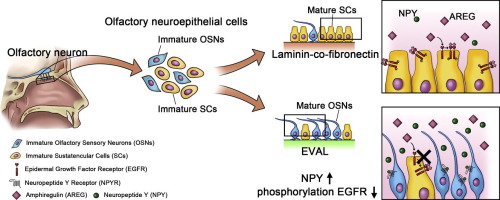Acta Biomaterialia ( IF 9.4 ) Pub Date : 2017-12-26 , DOI: 10.1016/j.actbio.2017.12.029 Sheng-Tien Li , Tai-Horng Young , Tsung-Wei Huang

|
Olfactory dysfunction significantly influences patients’ life quality, but currently has no adequate treatment. Poly (ethylene-co-vinyl alcohol) (EVAL) mediates cell adhesion, growth and modulates differentiation of neural stem cells. However, whether EVAL is a suitable substrate to establish an in vitro culture system that can promote development and differentiation of human olfactory neuroepithelial cells (HONCs) remains unexplored. This study isolates and cultures HONCs on controls and EVAL films for 21 days. The effects of treatment are assessed using immunocytochemistry, microarray analysis, quantitative PCR, ELISA and western blots following culturing. Most of the cell morphology on controls is epithelial and expresses markers of sustatencular cells (SCs), cadherin-1 and cytokeratin18, whereas the main population on EVAL presents as morphology with extended thin processes and possesses markers of mature olfactory sensory neurons (OSNs), olfactory marker protein (OMP). Microarray analyses reveal neuropeptide Y (NPY) and amphiregulin (AREG) are the two important regulating factors on EVAL films. HONCs cultured on EVAL films enhance the development of mature OSNs through NPY signaling, and significantly decrease the growth of SCs by blocking epidermal growth factor receptor (EGFR) activation. EVAL is a potential biomaterial to serve as an ideal substrate for treating olfactory dysfunction in the future.
Statement of significance
Olfaction not only contributes to enjoyments of food, but provides a clue to escape from dangerous environmental hazards. However, loss of smell is commonly progressive and there is no good prognostic approach for olfactory dysfunction. Here, we use poly (ethylene-co-vinyl alcohol) (EVAL) to establish an in vitro culture system that promotes development and differentiation of human olfactory neuroepithelial cells. We show that EVAL not only enhances the development of mature olfactory sensory neurons through neuronpeptide Y signaling, but significantly protects the olfactory neuroepithelium from metaplasia by inhibiting EGFR activation. Therefore, EVAL is a potential biomaterial to serve as an ideal substrate for treating olfactory dysfunction in the future.
中文翻译:

聚(乙烯-共-乙烯醇)是体外人嗅神经上皮细胞通过确定的调节途径分化的合适底物
嗅觉功能障碍会严重影响患者的生活质量,但目前尚无适当的治疗方法。聚(乙烯-共-乙烯醇)(EVAL)介导细胞粘附,生长并调节神经干细胞的分化。然而,EVAL是否是合适的底物来建立可以促进人类嗅觉神经上皮细胞(HONCs)发育和分化的体外培养系统。这项研究将21天的对照和EVAL胶片上的HONC分离并培养。培养后,使用免疫细胞化学,微阵列分析,定量PCR,ELISA和western印迹评估治疗效果。对照细胞的大多数细胞形态是上皮细胞,并表达sustatencular细胞(SCs),cadherin-1和cytokeratin18,而EVAL上的主要种群表现为形态学,扩展了稀薄的过程,并拥有成熟的嗅觉感觉神经元(OSNs)的标记,嗅觉标记蛋白(OMP)。芯片分析表明,神经肽Y(NPY)和双调蛋白(AREG)是EVAL膜上的两个重要调节因子。在EVAL膜上培养的HONC通过NPY信号增强成熟OSN的发育,并通过阻止表皮生长因子受体(EGFR)激活而显着降低SC的生长。EVAL是一种潜在的生物材料,可作为将来治疗嗅觉功能障碍的理想底物。
重要声明
嗅觉不仅有助于食物的享用,而且为摆脱危险的环境危害提供了线索。然而,气味的丧失通常是进行性的,并且对于嗅觉功能障碍没有好的预后方法。在这里,我们使用聚(乙烯-共-乙烯醇)(EVAL)建立体外培养系统,以促进人类嗅觉神经上皮细胞的发育和分化。我们显示,EVAL不仅通过神经肽Y信号增强了成熟的嗅觉感觉神经元的发育,而且通过抑制EGFR激活显着保护了嗅神经上皮免于化生。因此,EVAL是一种潜在的生物材料,可作为将来治疗嗅觉功能障碍的理想底物。











































 京公网安备 11010802027423号
京公网安备 11010802027423号